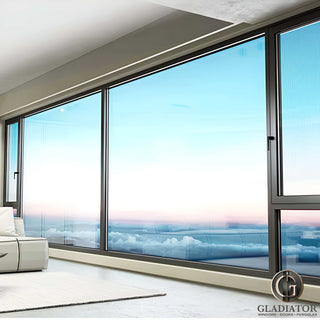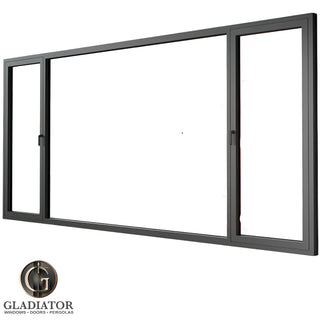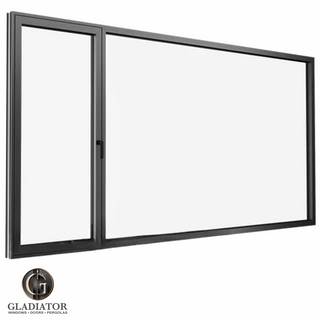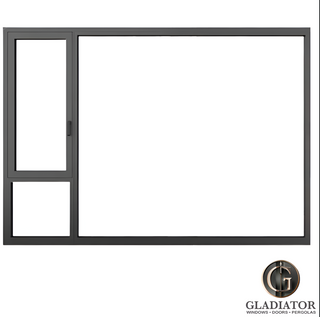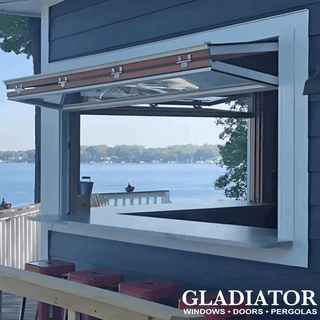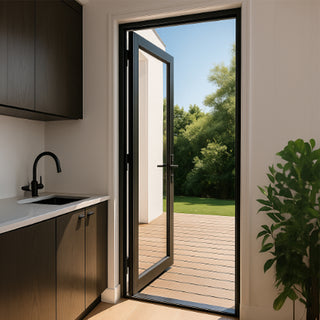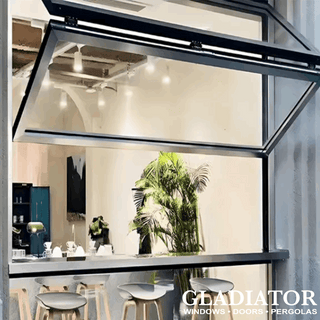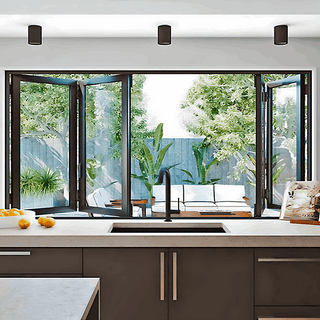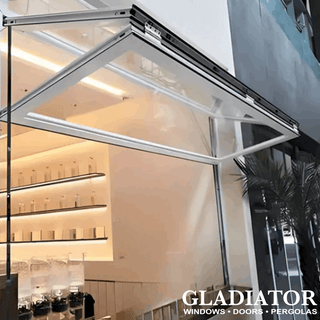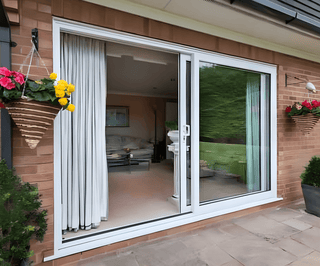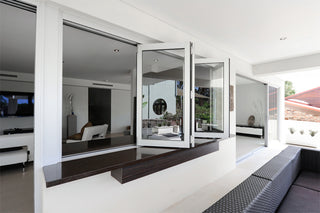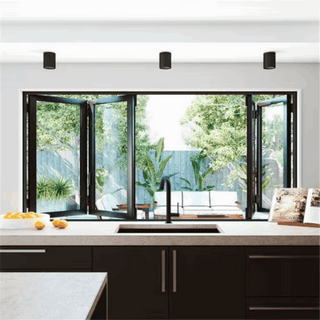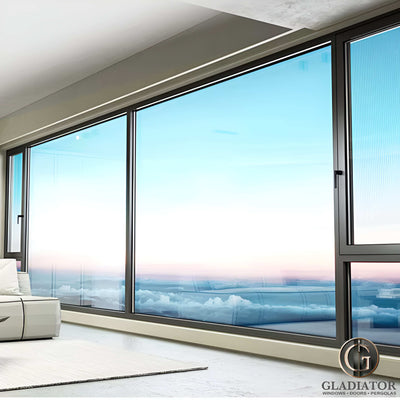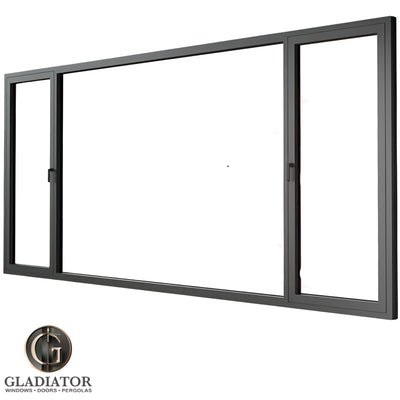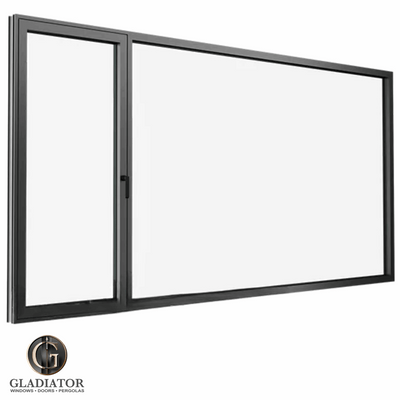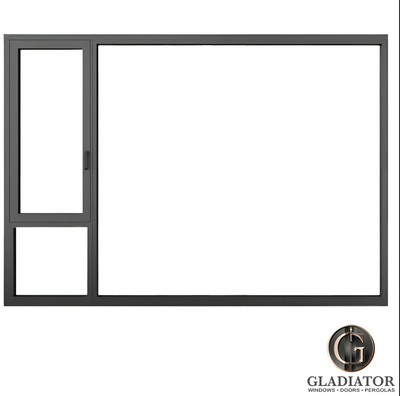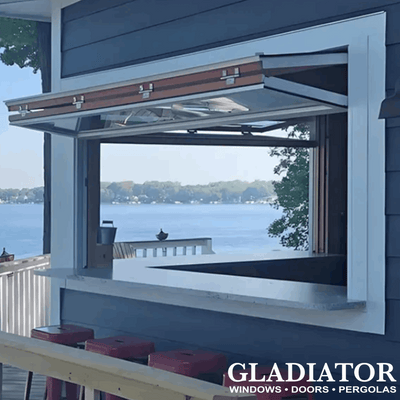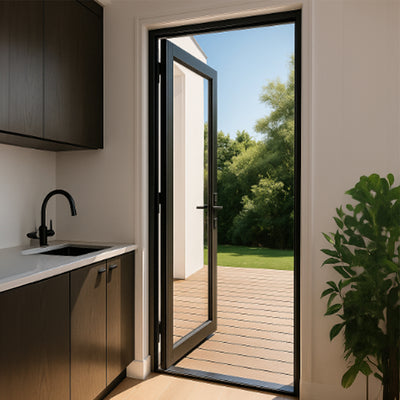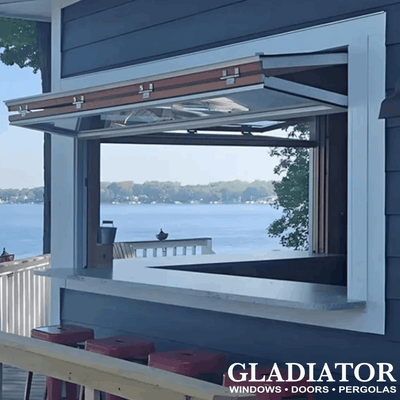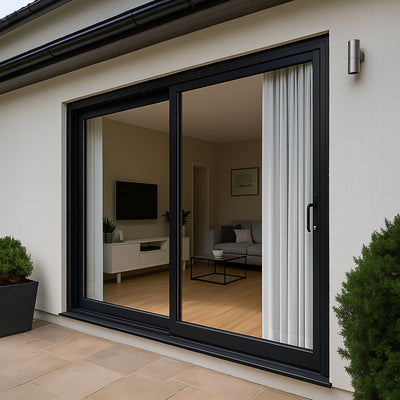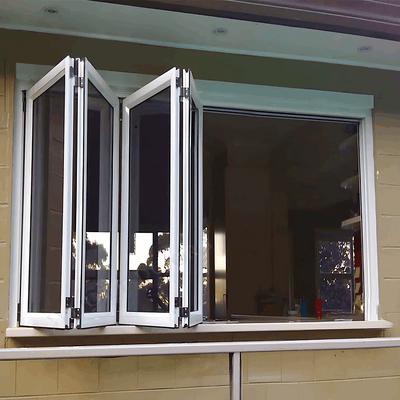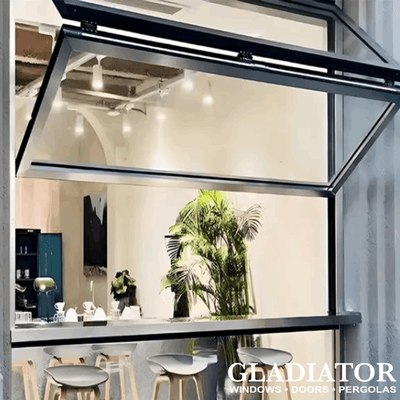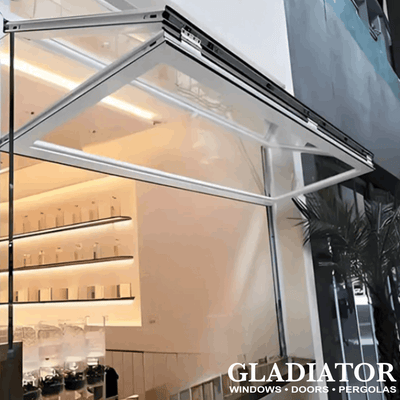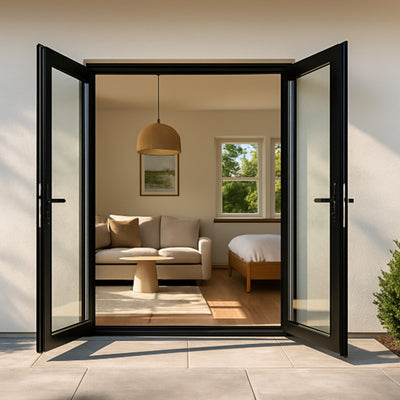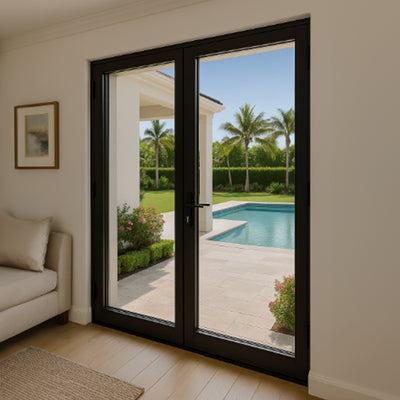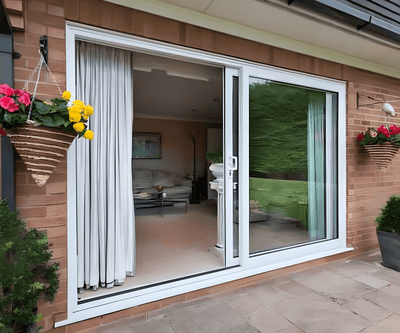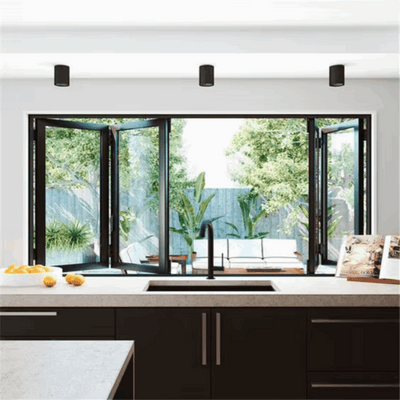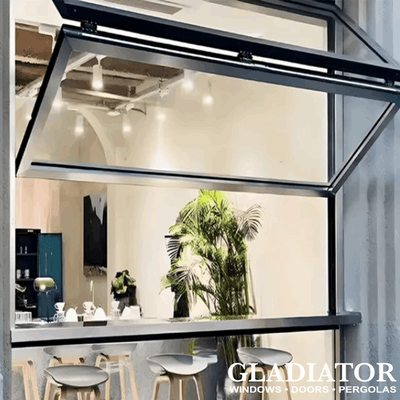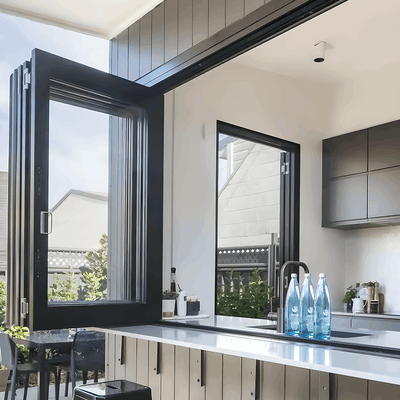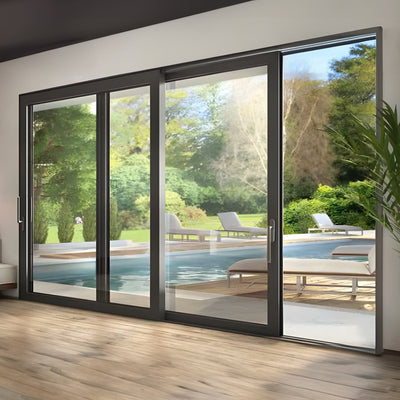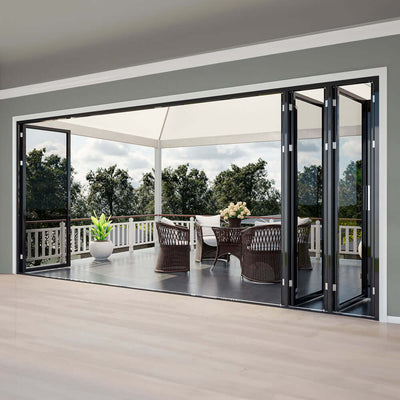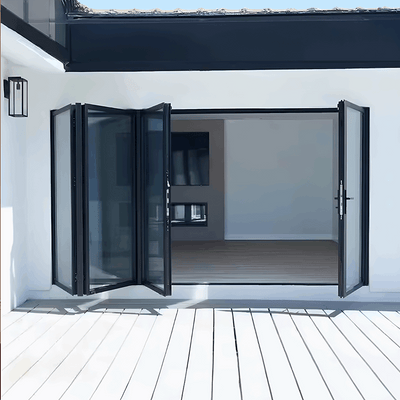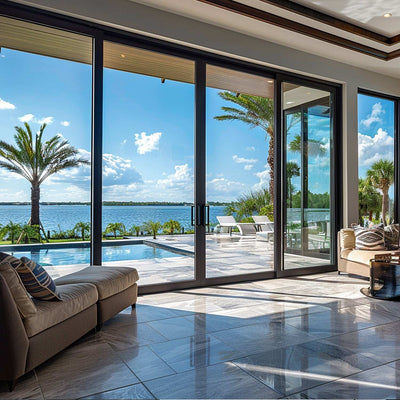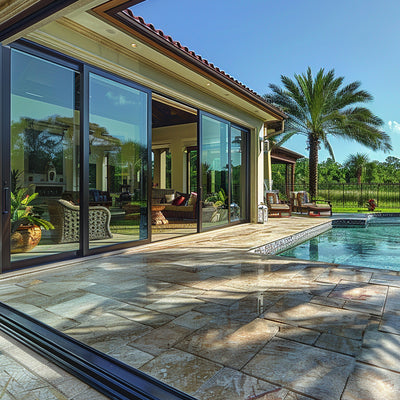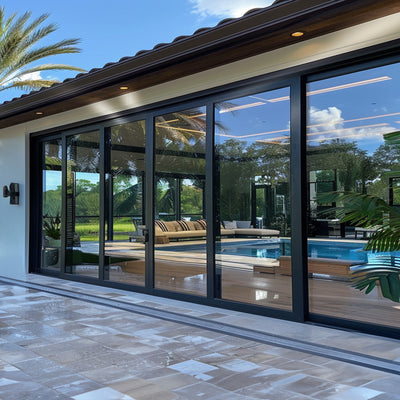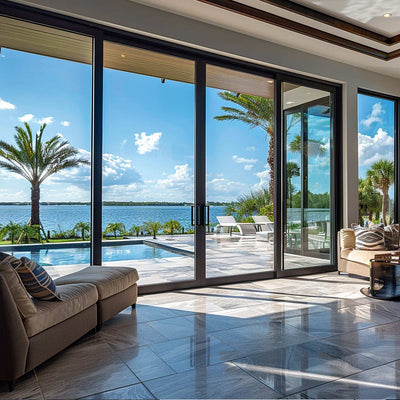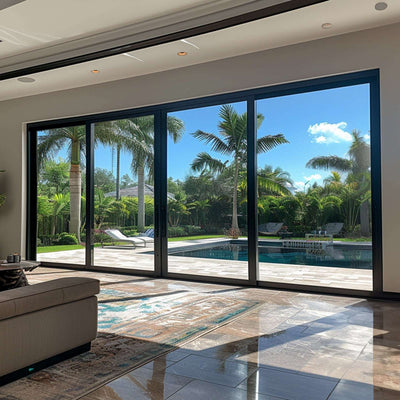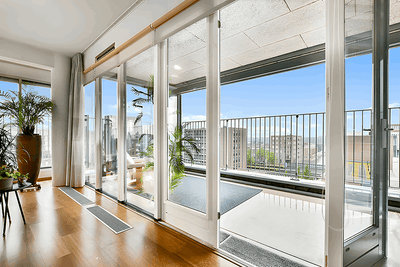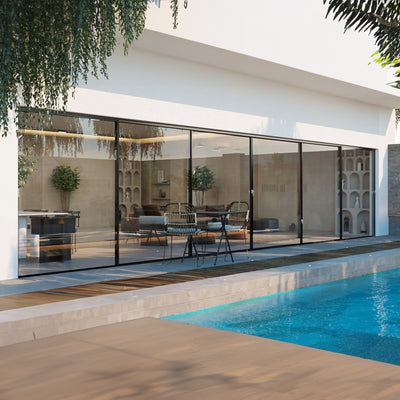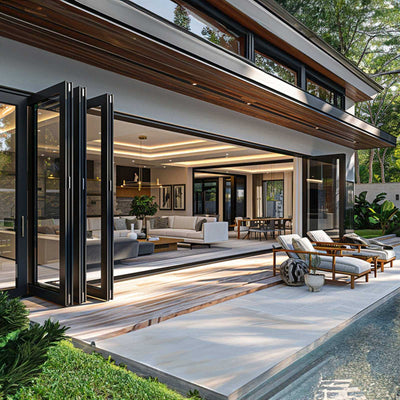Why Bifold Doors Transform Modern Living Spaces
Bifold doors are quickly becoming a desirable addition to modern homes, and with good reason. These flexible installations blend practicality and style, seamlessly merging indoor and outdoor spaces. Imagine effortlessly extending your living room onto a patio or opening your kitchen to a garden view. This integration of the outdoors reflects a desire for open, airy spaces that connect us with nature.
Expanding Space and Light
One key benefit of bifold doors is their ability to maximize space. Unlike traditional sliding or French doors, bifold doors fold neatly away, creating a wide, unobstructed opening. This maximizes usable square footage, making rooms feel larger.
The expansive glass panels also flood interiors with natural light. This not only brightens the space, but also creates a more welcoming atmosphere. This natural light can even lead to energy savings by reducing the need for artificial lighting.
Enhancing Aesthetics and Value
Beyond functionality, bifold doors enhance a home's architectural character, adding a touch of modern elegance. Whether your style is contemporary or traditional, bifold doors can complement existing décor.
This popularity is reflected in market trends. As of 2024, the global bifold doors market was valued at approximately USD 10.9 billion, projected to reach USD 15.6 billion by 2033. This growth is fueled by demand for smart homes, energy efficiency, and renovations. Find more detailed statistics here: https://www.imarcgroup.com/bifold-doors-market
Investing in bifold doors enhances living space and adds significant value to a property.
Choosing the Right Materials
The material you choose affects both appearance and performance. Common options include wood, aluminum, and uPVC. Wood offers a classic look but requires maintenance. Aluminum is known for durability and slim profiles. uPVC provides excellent energy efficiency and is a budget-friendly option. Considering these factors will help you select the right material.
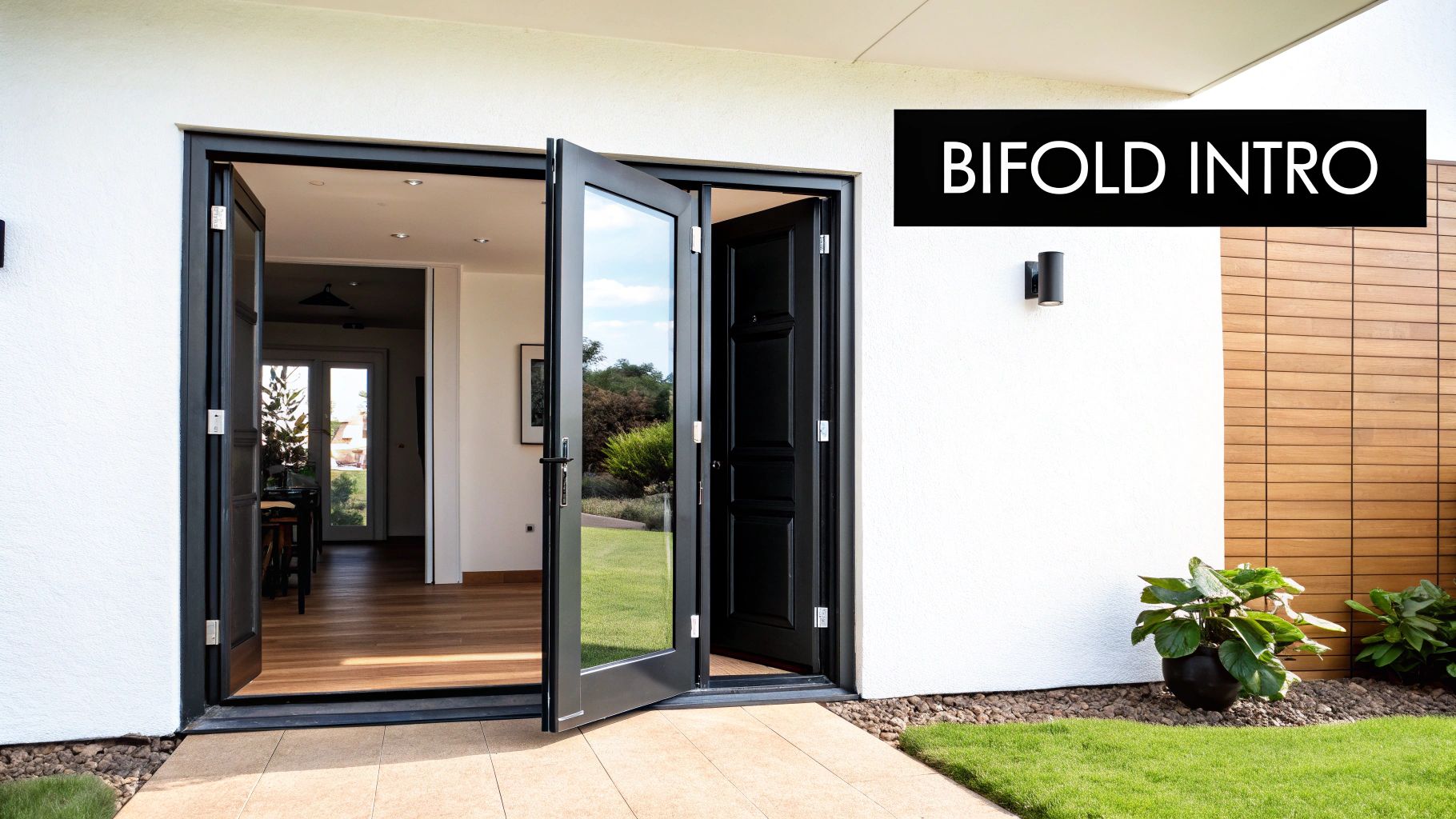
Essential Tools for Successful Bifold Door Installation
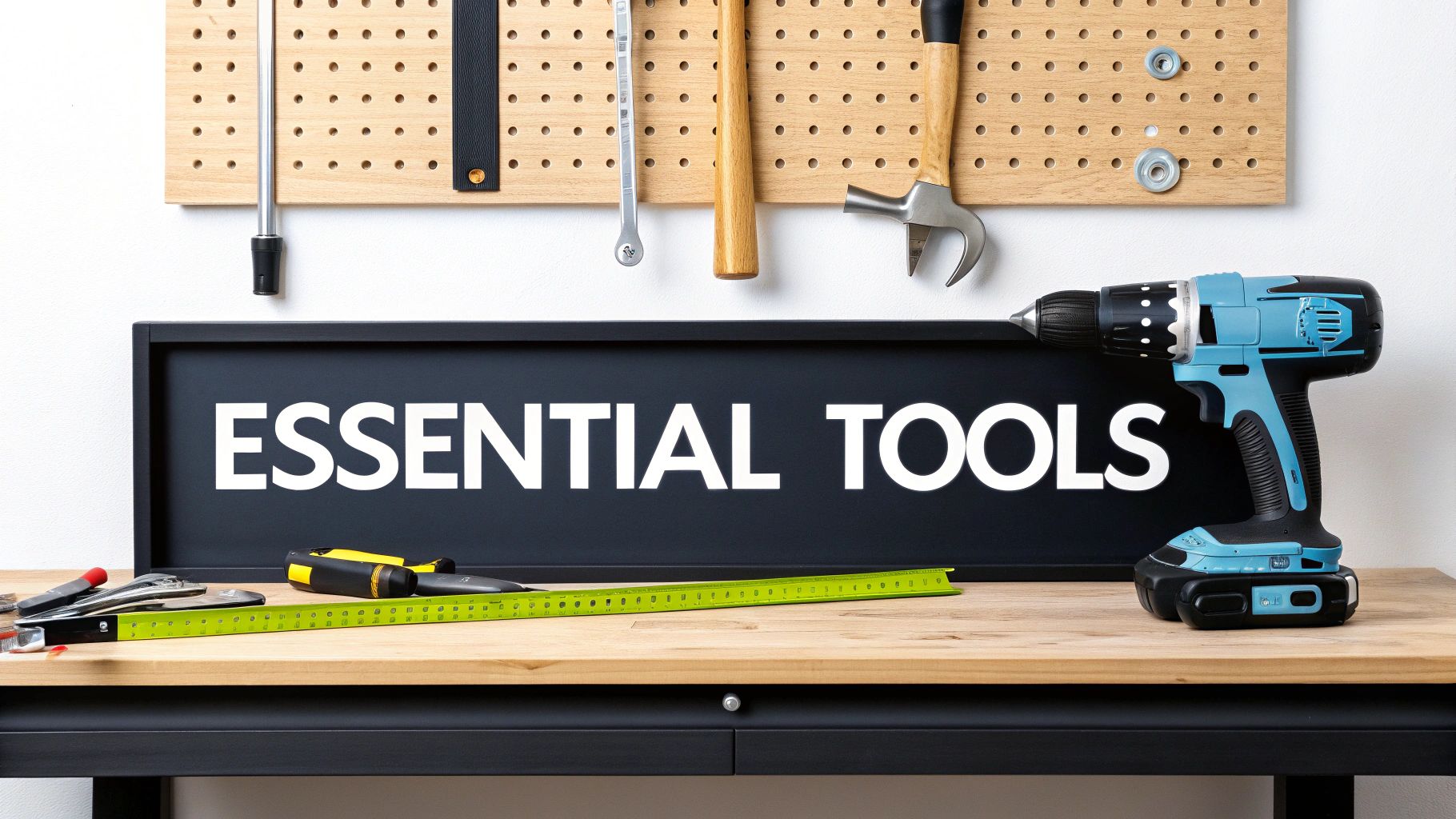
Getting ready to install bifold doors? Think of it like prepping for a big cooking project. You need the right ingredients, and in this case, those ingredients are your tools. Having the right tools from the start will make the installation process smoother and give you a professional-looking result. This means having everything at your fingertips, from measuring tools to specialized bifold door hardware.
Measuring and Marking Tools
Precise measurements are the foundation of a successful bifold door installation. It's not just about the rough opening. You also need to factor in things like flooring transitions and trim. A laser measure is perfect for large openings, providing incredibly accurate readings. You'll also want a standard tape measure, a level, and a pencil to mark and double-check those measurements.
- Laser Measure: Great for quickly and accurately measuring long distances.
- Tape Measure: A must-have for smaller areas and taking detailed measurements.
- Level: Use this to make sure your track and door panels are perfectly plumb and level.
- Pencil: This will help you make clear marks on all kinds of surfaces.
Cutting and Fastening Tools
After measuring, you'll need tools to get the opening ready and secure all the door parts. You might need a circular saw or jigsaw for trimming or adjusting the opening. A drill with the right drill bits and a screwdriver are key for attaching the track and frame. A reciprocating saw is handy for those unexpected adjustments.
- Circular Saw/Jigsaw: These tools offer precise cutting and trimming for a perfect fit.
- Drill: Use this for pilot holes and driving screws.
- Screwdriver: Secure all screws tightly with a screwdriver.
- Reciprocating Saw: This is a great tool for removing existing framing or making any needed adjustments.
Specialized Tools and Hardware
Bifold doors use special hardware, including pivot hinges, rollers, and tracks. Having the correct tools for this hardware is essential. Shims let you make small adjustments for perfect alignment, while a rubber mallet helps tap parts into place without damaging them. Check out this resource: How to master your bifold door installation project.
- Shims: Level and align the door frame and track with shims.
- Rubber Mallet: Use a rubber mallet to gently tap components into position without damaging the surfaces.
Before we continue, let's look at the tools summarized in the following table:
Essential Tools for Bifold Door Installation: A comprehensive list of required tools and their purposes for a successful installation
| Tool | Purpose | Recommended Type | Alternatives |
|---|---|---|---|
| Laser Measure | Accurately measures long distances | Self-leveling | Tape Measure |
| Tape Measure | Detailed measurements and smaller areas | 25-foot | Retractable Tape Measure |
| Level | Ensures plumb and level installation | Torpedo Level | Standard Level |
| Pencil | Marking on various surfaces | Carpenter's Pencil | Marking Pen |
| Circular Saw/Jigsaw | Cutting and trimming materials | Corded or Cordless | Hand Saw |
| Drill | Creating pilot holes and driving screws | Cordless Drill | Impact Driver |
| Screwdriver | Fastening screws | Variable Speed | Manual Screwdriver |
| Reciprocating Saw | Removing existing framing or making adjustments | Corded or Cordless | Hacksaw |
| Shims | Leveling and aligning the door frame and track | Wood or Composite Shims | Adjustable Shims |
| Rubber Mallet | Gently tapping components into place | Soft-faced Rubber Mallet | Hammer with a protective cover |
This table outlines the essential tools and their alternatives for a smooth bifold door installation. Choosing the right tools will make the process efficient and ensure a professional finish.
Having the right tools sets you up for a smooth and efficient bifold door installation. This attention to detail leads to a beautiful, functional door that enhances your living space. A solid foundation with the proper tools ensures your bifold doors work perfectly for years to come.
The Step-by-Step Bifold Door Installation Blueprint
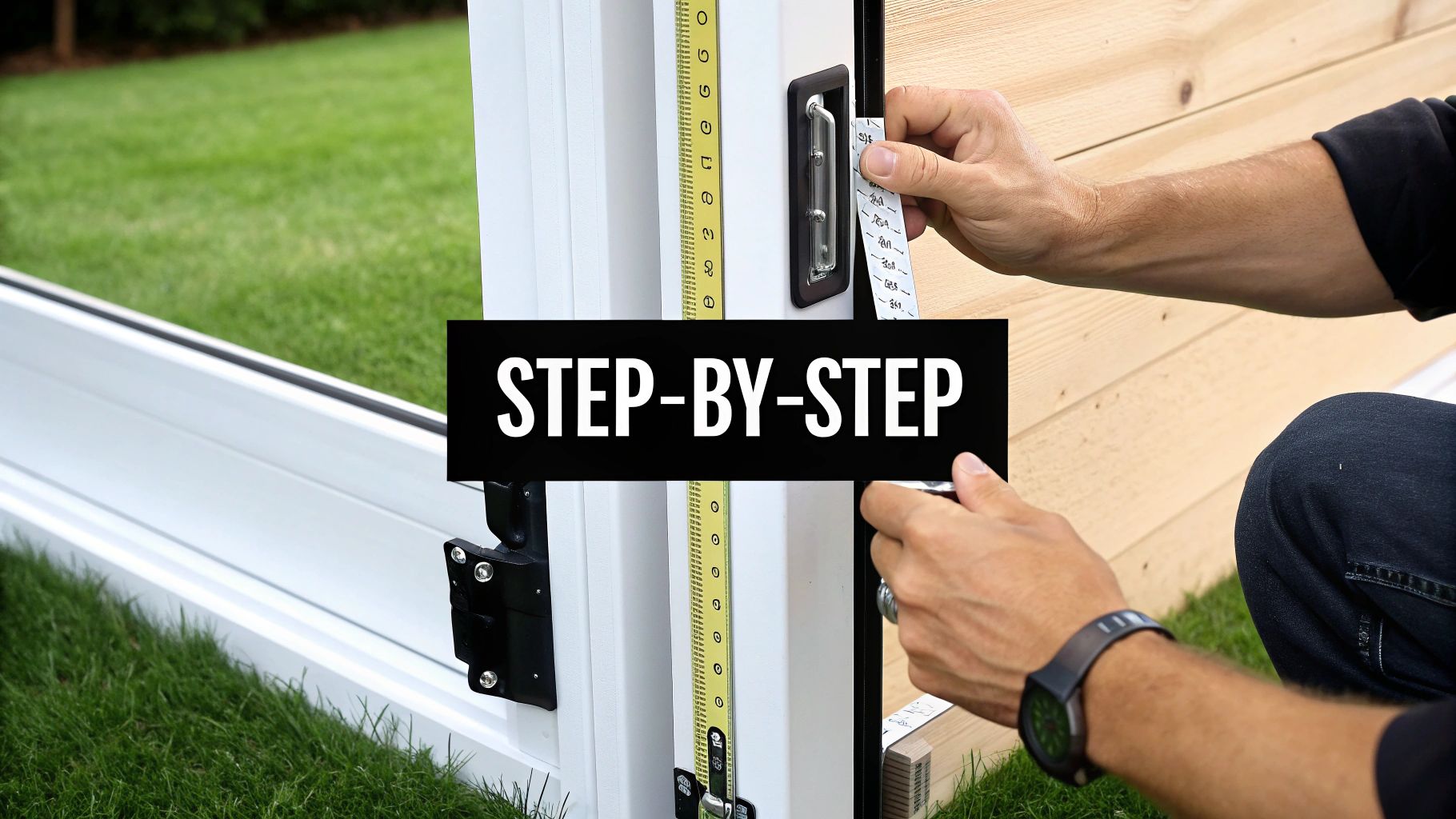
Installing bifold doors can feel overwhelming, but breaking the process down into smaller steps makes it achievable, even for DIYers. This guide, drawing on advice from experienced carpenters, provides a clear roadmap to a successful installation.
Preparing the Opening
Just like a solid foundation is essential for a house, proper preparation of the opening is crucial for bifold doors. This means carefully measuring the rough opening and ensuring it's square, plumb, and level. Inaccuracies at this stage will create problems later.
- Measure Twice, Cut Once: Double-checking measurements is essential before making any changes to the opening.
- Level and Plumb: Use a level to ensure vertical sides (plumb) and horizontal top and bottom edges (level).
- Square Up: Confirm the corners form 90-degree angles. An out-of-square opening will cause the doors to bind.
Mounting the Track System
After preparing the opening, the next step is installing the track system. The track is the backbone of the installation, ensuring smooth door operation. Secure and accurate track installation is vital for long-term performance.
- Pre-Drill Pilot Holes: Pre-drilling helps prevent the track from splitting and ensures straight screw placement.
- Secure with Appropriate Fasteners: Use screws suited to your wall material (e.g., wood, concrete).
- Check for Level: After securing the track, double-check it's level to make any necessary adjustments.
Installing the Hardware and Hanging the Doors
With the track installed, you can install the pivot hardware and hang the door panels. This stage brings the installation together. Hang each panel carefully, ensuring proper alignment and smooth movement.
- Install Pivot Hinges: These hinges enable the doors to fold and unfold smoothly. Make sure they are securely fastened to both the panels and the track.
- Hang Door Panels Sequentially: Follow the manufacturer’s instructions for the correct panel hanging order.
- Adjust for Smooth Operation: Check each panel's movement along the track, adjusting as needed for smooth gliding.
Making Final Adjustments
Final adjustments distinguish a professional installation. This includes adjusting the rollers, ensuring uniform gaps between panels, and testing the locking mechanism.
- Adjust Roller Height: Correct roller height ensures effortless opening and closing.
- Even Panel Gaps: Adjust the hardware to maintain consistent gaps between panels, improving both appearance and function.
- Check Locking Mechanism: Ensure the locking mechanism engages smoothly and securely.
These small details significantly impact the doors’ smooth operation and lifespan.
To help visualize the installation process, the following table outlines the estimated time required for each phase, categorized by experience level:
Bifold Door Installation Timeline
| Installation Phase | Beginner (hrs) | Intermediate (hrs) | Expert (hrs) |
|---|---|---|---|
| Preparing the Opening | 4 | 3 | 2 |
| Mounting the Track System | 3 | 2 | 1 |
| Installing the Hardware and Hanging the Doors | 5 | 3 | 2 |
| Making Final Adjustments | 2 | 1 | 0.5 |
As you can see, experience plays a significant role in installation time. While beginners may take up to 14 hours, experts can complete the process in around 5.5 hours.
The growing popularity of bifold doors, especially in regions like Asia-Pacific and North America, reflects their modern aesthetic and practicality. For further insights into this market trend, see: https://www.researchnester.com/reports/bifold-doors-market/6046
Troubleshooting Tips
Even with meticulous planning, issues can arise. For guidance on common bifold door problems and solutions, refer to: How to troubleshoot bifold door issues. This proactive approach will save you time and potential frustration. By following these steps and addressing any problems, you can transform your space with beautiful, functional bifold doors.
Troubleshooting Bifold Door Issues Like a Pro
Even with a perfect installation, bifold doors can sometimes act up. Knowing how to troubleshoot these problems can save you time and headaches, keeping your doors running smoothly. This section addresses common issues DIYers encounter and offers practical fixes.
Diagnosing Common Problems
One common issue is binding. This happens when door panels rub against each other or the frame, making them hard to open and close. Several things can cause this, such as loose hardware, a misaligned track, or even the house settling. Another frequent problem is misalignment, where the panels don't line up, creating gaps or making folding difficult. This can be due to improper installation or warping of the panels.
-
Binding: Check the track for obstructions or damage. Tighten any loose screws on the hinges and rollers. If the problem continues, the track might need adjusting or replacing.
-
Misalignment: Inspect the track's alignment, making sure it's level and plumb. Adjust the hinges and rollers to get the panels back in line.
Adjusting Tracks, Pivots, and Guides
Minor tweaks to the track, pivots, and guides often solve many bifold door problems. A slightly bent track, for instance, can cause noticeable binding. Carefully straightening it can restore smooth operation. Also, adjusting the pivots can realign the panels and close gaps. You might be interested in: How to master your bifold door installation project.
-
Track Adjustment: Use a level to ensure the track is aligned. Small bends can often be straightened gently. Significant damage might require track replacement.
-
Pivot Adjustment: Adjusting the pivot screws can fix minor alignment problems.
Preventative Maintenance for Long-Term Performance
Like regular car maintenance prevents breakdowns, routine care for your bifold doors keeps them working well for years. Lubricating the track and hinges regularly minimizes friction and prevents binding. Cleaning the track removes debris that can interfere with the rollers. This simple upkeep can prevent bigger issues down the line. The growth of multifamily housing and home renovations is expected to increase demand for these doors. Additionally, factors like the COVID-19 pandemic and geopolitical issues have affected the market, but investment in infrastructure and smart technologies should drive future growth. Learn more: https://www.thebusinessresearchcompany.com/report/bifold-doors-market
-
Lubrication: Apply a silicone-based lubricant to the track and hinges every six months for smooth operation.
-
Cleaning: Regularly remove any debris from the track that could obstruct the rollers.
-
Inspection: Periodically check all hardware for wear, tightening loose screws as needed.
By understanding these troubleshooting tips and performing preventative maintenance, you can ensure your bifold doors remain a beautiful and functional part of your home for years. Addressing these common problems proactively keeps them working smoothly and extends the life of your investment.
Elevating Your Installation With Premium Hardware
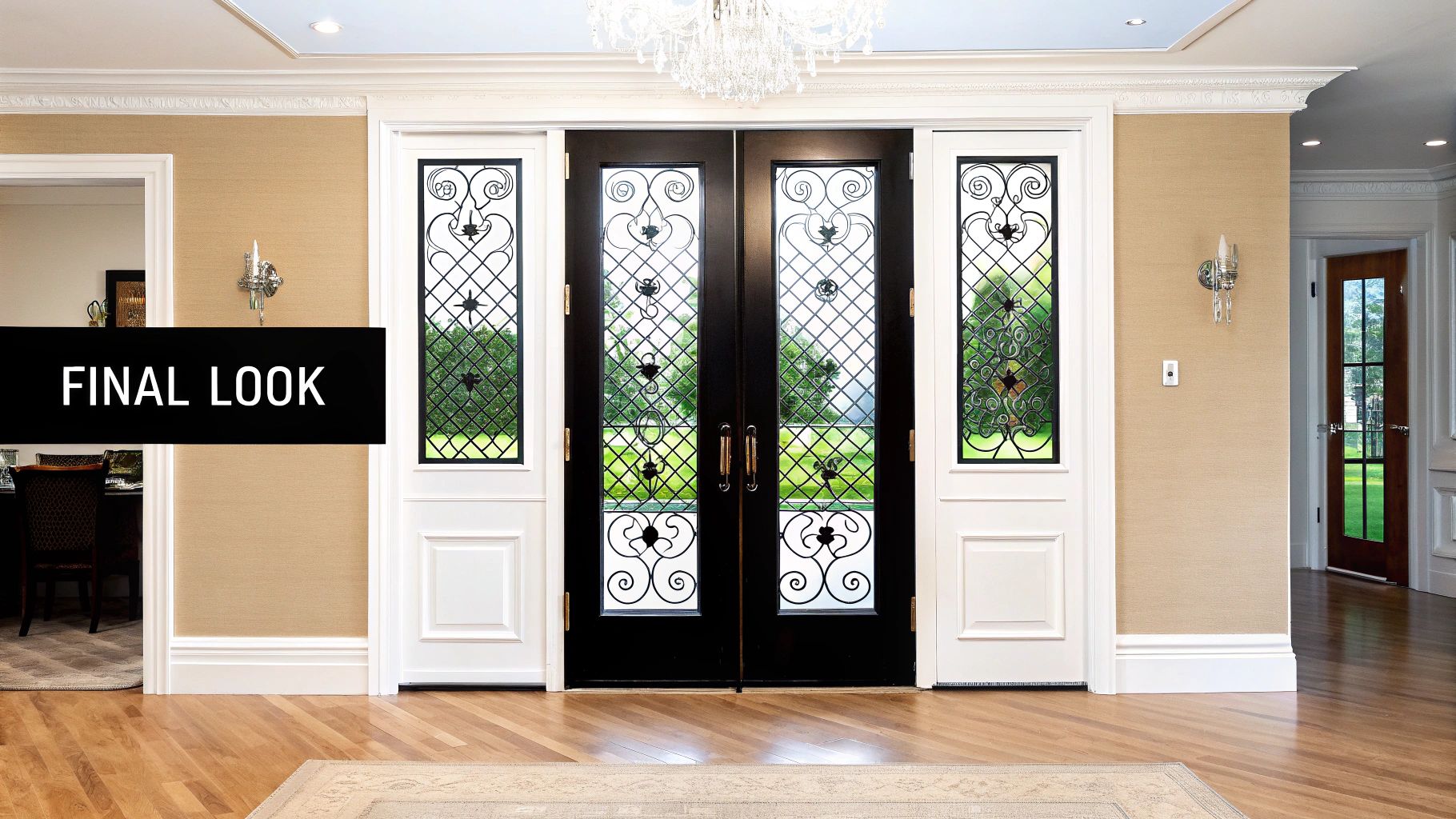
A properly installed bifold door system is essential for functionality. But choosing the right hardware can truly elevate its design. Think of hardware as the jewelry for your doors – the perfect accessories can make them shine. Handles, pulls, locks, and other decorative accents play a vital role in both the usability and the overall look of your bifold doors.
Hardware Styles and Trends
Hardware choices significantly influence the overall design aesthetic. Sleek, minimalist handles complement modern interiors. Ornate pulls and decorative hinges can enhance a more traditional look. Even the finish makes a difference. Brushed nickel offers a contemporary feel, while oil-rubbed bronze exudes warmth and classic charm. You might be interested in: Tips for selecting bifold door hardware.
- Contemporary: Choose streamlined handles in brushed nickel or stainless steel.
- Traditional: Consider classic knobs or ornate pulls in oil-rubbed bronze or antique brass.
- Transitional: A blend of modern and traditional styles is possible. Look for hardware that incorporates both clean lines and decorative elements.
Professional Finishing Techniques
The finish you choose not only enhances visual appeal but also protects your investment. Proper preparation is crucial. This includes thoroughly cleaning and priming the surface before applying your chosen finish. For wood bifold doors, a high-quality stain or paint offers protection against weather and wear. Applying multiple thin coats, with light sanding between each, creates a smoother, more durable finish.
Smart Technology Integration
Technology is changing how we interact with our homes, including our bifold doors. Automated opening systems provide convenience and accessibility, allowing you to open and close your doors with a touch of a button or even voice commands. These systems can often integrate with smart home platforms like Amazon Alexa or Google Home, giving you remote control of your doors.
- Automated Opening: Motorized systems are especially convenient for large or heavy bifold doors.
- Security Features: Increase security and peace of mind with smart locks and sensors.
- Integration with Smart Home Platforms: Connect your bifold door system to other smart devices for a seamless and integrated home experience.
Maintenance Considerations
Like any home investment, proper maintenance is essential. It will keep your bifold doors and hardware looking and functioning beautifully. Regular cleaning and lubrication are key. Wipe down hardware with a soft cloth to remove dust and grime. Lubricate moving parts, such as hinges and tracks, to maintain smooth operation.
By carefully considering hardware and finishing touches, you transform your bifold door installation. It becomes more than just functional; it becomes a beautiful, user-friendly feature in your home. This attention to detail not only enhances your home’s aesthetics but also protects your investment for years to come.
Customizing Bifold Doors for Regional Conditions
Bifold doors offer incredible versatility and style, but their installation isn't a one-size-fits-all process. Much like choosing the right clothing for the season, selecting and installing bifold doors requires careful consideration of the local climate and architectural style. Understanding these regional nuances is essential for a successful, durable, and visually appealing installation.
Material Selection for Diverse Climates
Different climates present unique challenges for bifold doors. Coastal areas, with their salty air, demand corrosion-resistant materials such as aluminum or uPVC. In regions with significant temperature fluctuations, thermally efficient materials are crucial. Thermally broken aluminum or uPVC frames with insulated glass units minimize energy loss and maintain comfortable indoor temperatures throughout the year. In humid climates, materials resistant to rot and decay, like powder-coated aluminum, are vital to prevent long-term damage.
-
Coastal Regions: Aluminum or uPVC frames provide excellent corrosion resistance against the damaging effects of salt air.
-
Extreme Temperatures: Thermally broken aluminum or uPVC frames with insulated glass units effectively prevent heat transfer, keeping your home comfortable regardless of the outside temperature.
-
High Humidity: Powder-coated aluminum frames resist rot and decay, ensuring longevity even in moist environments.
Installation Modifications for Challenging Conditions
Beyond material selection, installation techniques must also adapt to regional conditions. In windy locations, reinforcing the frame and using high-wind resistant hardware is essential, similar to strengthening a house frame to withstand a hurricane. In snowy climates, incorporating weather stripping and sealing around the frame minimizes drafts and prevents snow from entering, keeping your home warm and cozy throughout winter. Finally, in earthquake-prone areas, flexible framing and anchoring systems offer increased stability, much like how skyscrapers use flexible joints to withstand tremors.
-
Wind-Prone Areas: Reinforced frames and specialized high-wind resistant hardware provide protection against strong winds.
-
Snowy Climates: Proper weather stripping and sealing prevent drafts and keep snow out.
-
Earthquake Zones: Flexible frames and robust anchoring systems are crucial for added stability in earthquake-prone regions.
Blending With Regional Architecture
Bifold doors should seamlessly integrate with the surrounding architectural style. In modern homes, sleek aluminum frames with large glass panels achieve a clean, contemporary look. For traditional homes, wood frames with divided lites offer timeless charm. In rustic settings, wood frames with natural finishes blend beautifully with the natural landscape. Choosing the right materials and finishes ensures your bifold doors complement your home's architectural character.
Consider this table illustrating how bifold doors can be adapted for various regional needs:
| Region | Climate | Architectural Style | Bifold Door Features |
|---|---|---|---|
| Coastal | High humidity, salt air | Modern, Beach House | Aluminum or uPVC frames, corrosion-resistant hardware, large glass panels |
| Mountain | Extreme temperatures, snow | Rustic, Cabin | Wood or thermally broken aluminum frames, insulated glass, weather sealing |
| Desert | Extreme heat, intense sunlight | Southwestern, Modern | Thermally efficient glass, sun-reflective coatings, desert-toned frames |
These considerations highlight how bifold doors can enhance both the functionality and aesthetics of any home, regardless of climate or architectural style.
Ready to transform your home with beautiful, functional, and regionally optimized bifold doors? Visit Gladiator Window and Doors to explore our wide selection of high-quality, custom-made bifold doors. We offer the lowest prices in the USA, backed by our Best Offer Guarantee, ensuring you receive unbeatable value without compromising quality.

















